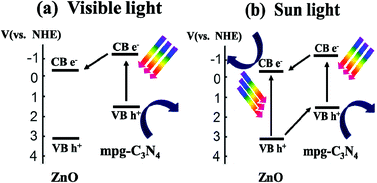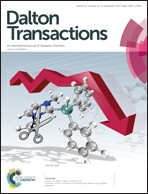Synthesis and characterization of the ZnO/mpg-C3N4 heterojunction photocatalyst with enhanced visible light photoactivity†
Abstract
The ZnO/mpg-C3N4 composite photocatalyst with high visible light activity was successfully synthesized by a facile solvothermal method and characterized by thermogravimetric analysis (TGA), X-ray diffraction (XRD), transmission electron microscopy (TEM), high-resolution transmission electron microscopy (HRTEM) and UV-vis diffuse reflectance spectroscopy (DRS). The results indicated that ZnO particles dispersed uniformly on the mpg-C3N4 sheet. The photocatalytic activity of ZnO/mpg-C3N4 for photodegradation of MB was much higher than that of pure mpg-C3N4 both under the visible light and simulated solar irradiation. The optimal ZnO content for the photocatalytic activity of the ZnO/mpg-C3N4 composites is 24.9%, which is almost 2.3 times as high as that of pure mpg-C3N4 under visible light, and 1.9 times higher than that under simulated solar irradiation. The enhancement in photocatalytic activity should be assigned to the effective separation and transfer of photogenerated charges coming from the well-matched overlapping band-structure between mpg-C3N4 and ZnO. Radical trap experiments show that both ZnO/mpg-C3N4 composites and mpg-C3N4 have the same photodegradation mechanism, and the holes are their main oxidative species for MB degradation.


 Please wait while we load your content...
Please wait while we load your content...